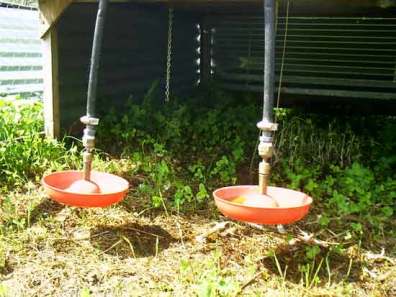Movable Pastured Poultry Cage Plans
♣ 1 meg PDF Movable Poultry Cage Plan, lower print quality, faster download
♣ 3 meg PDF Movable Poultry Cage Plan, better print quality, slower download
*Click on photos below to enlarge them.

Above-Pastured poultry cage with lids open for feeding and cleaning water dishes. Breeds in this photo are slower growing Red and Bronze Rangers. Cages are moved daily to provide fresh forage for the chickens, keep their area clean to avoid diseases, and to distribute manure that provides nutrients for pasture growth. A dolly with a wedge (see other photo) is placed under the rear, the front is picked up by a handle (seen above center front of cage – thick rope with short PVC length for a handle) and the cage moved forward a cage length each day. Normally only one person is needed to move the cage. Four corner handles are for moving cages with more people longer distances or in and out of the fields.
Above-Side view of Pasture Poultry Cages. The siding provides shade, the lid can be raised and the bottom slightly propped up during hotter weather for greater airflow.
Above-Good view showing grazed pasture from previous days. The grazed area quickly regrows with the addition of the chicken manure.
Above-4-gallon water buckets on top of the Pasture Poultry Cage provide a constant flow of water for waterers. A hole is cut in a regular bucket, a barrel bung and valve are inserted, then is plumbed to the waterers via garden dripline. Other sized buckets and types of plumbing can be used. A valve (optional) makes the bucket removable without losing all the water. We always used two totally independent watering units as backups in case of malfunction of one.
Above-We later used nipple waterers with the above 4 gallon buckets. These were superior to the hanging bell waterers as they didn’t clog like the bell waterers did nor did they have a dish that had to be cleaned out.
Above-The dolly slips under the back of the Pasture Poultry Cage and the wooden wedge is put in to hold the dolly tipped back so the rear bottom of the cage is a few inches off the ground. The cage is pulled forward by a rope on the front of the cage. A person does not have to hold the dolly when the cage is moved so it can be a one-person job. The person must carefully watch chickens at the back of the pen to make sure all chickens are clear of the back and dolly as they move, and stop if there is any risk of one going under. When birds first go out it’s best to have a “shoosher” person at the back. After a few days they learn to follow the cage.
Above-Feeders made out of roof gutters are suspended from the cage “rafters” so they don’t have to be moved in and of the cage each time it’s moved. Feeders are made of a 3ft length of guttering with 2 gutter end caps. A spinning PVC roll bar to prevent chickens from perching on the feeder is made by suspending a ca 1/4″ diameter metal rod a couple inches over the feeder and placing a slightly shorter length of PVC over the rod. Height of the feeders is adjustable with hooks on the chains so it can be raised as the chickens grow.
Above-Having chickens that have been raised with a lot of human attention from first arrival from the hatchery is important. Tamer chickens are very pleasant to work with and are less stressed when handling is necessary. We introduce chicks to greenery (finely chopped pasture clover and grass) in the brooder so they know what it is when they get in the field. We also associate a “chicken call” when greens are fed to chicks to teach them to come when called. This helps them to learn more quickly to move forward during cage moving time when they’re first put out in the Pasture Poultry Cage.
Above-Inside view of hanging bell waterers that automatically refill as water is drunk by the birds. Regular garden dripline is used to connect waterers to water source buckets (see below). Hanging waterers are time savers as they don’t have to be taken in and out of the cage when it’s being moved, and are quite easy to clean. In 2010 we changed to using nipple waterers (see below) as they were more reliable. Two totally independent watering systems are critical to provide backup in case one malfunctions, as a cage of approximately 35 larger birds can use 4 gallons on a hot day.








